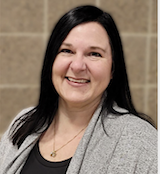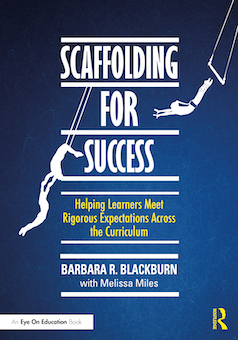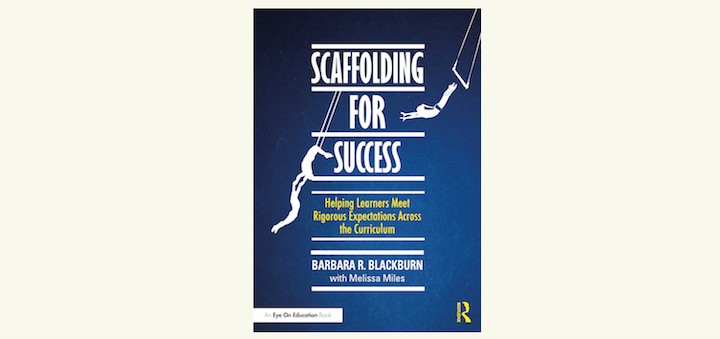Scaffolding for Success: Helping Learners Meet Rigorous Expectations Across the Curriculum
By Barbara R. Blackburn with Melissa Miles
(Routledge/Eye On Education, 2025 – Learn more)
Reviewed by Melinda Stewart

 In Scaffolding for Success: Helping Learners Meet Rigorous Expectations Across the Curriculum, authors Barbara R. Blackburn and Melissa Miles explore the intricacies of educational scaffolding and offer educators a comprehensive framework to design learning environments that enhance student engagement, learning and achievement.
In Scaffolding for Success: Helping Learners Meet Rigorous Expectations Across the Curriculum, authors Barbara R. Blackburn and Melissa Miles explore the intricacies of educational scaffolding and offer educators a comprehensive framework to design learning environments that enhance student engagement, learning and achievement.

 This book provides a blend of practical strategies and reflective prompts, encouraging readers to consider their teaching practices critically. Through a combination of theory, research based strategies, and examples, the authors create an accessible resource for educators seeking to enhance their instructional methods. With each page I read, I experienced the mindful preparation of authors providing scaffolds to help their readers access the learning.
This book provides a blend of practical strategies and reflective prompts, encouraging readers to consider their teaching practices critically. Through a combination of theory, research based strategies, and examples, the authors create an accessible resource for educators seeking to enhance their instructional methods. With each page I read, I experienced the mindful preparation of authors providing scaffolds to help their readers access the learning.
Blackburn and Miles begin by establishing a definition of rigor, emphasizing the role of scaffolding in a supportive framework that enables students to build knowledge incrementally and achieve at high levels.
They describe scaffolding it as a dynamic and supportive system of teaching that facilitates learning, helping students build knowledge step by step. Their approach connects theory to practice and illustrates how scaffolding techniques can be tailored to meet diverse learning needs.
Scaffolding beyond academics
An essential component of the scaffolding process is a focus on the emotional and relational dimensions of student support. Scaffolding is not solely about academics – it’s also about creating a safe, trusting, and empowering learning environment. Learners need to feel secure enough to take risks in their learning.
This emotional component connects to the authors’ definition of rigor. As they highlight, rigor is about challenging students intellectually, but more than that, it’s about creating an environment where each student is expected to perform at high levels, is supported in reaching those levels, and is held accountable for their progress.
Blackburn and Miles (successfully) argue that scaffolding is not a one-size-fits-all approach. As educators, we must assess who our students are – what their individual strengths, challenges and needs are – before deciding what type of scaffolding to implement. Sample scaffolding activities, lesson excerpts, and suggestions for resources all serve as guides to help teachers implement the strategies discussed.
Reaching higher levels of understanding
The authors stress that scaffolding should be purposeful and intentional. Teachers must plan for it in advance, focusing on acceleration rather than remediation. This means that scaffolding should be designed to challenge students to reach higher levels of understanding, not simply to revisit or fill in gaps.
I tend to think a lot about my classroom and classroom practices, but Scaffolding for Success: Helping Learners Meet Rigorous Expectations Across the Curriculum has brought focus back to my reflection. Am I spending too much time designing scaffolds and not enough time considering which students need which scaffolding? Secondly, scaffolding should help students become more self-reliant while still receiving the support they need to thrive. Is the scaffolding I am providing fostering independence or dependency?
The authors’ prompts for reflection encourage educators to assess their approaches critically and make adjustments that could lead to more significant student success. Beginning with a clear sense of purpose and a defined product will ensure that the scaffolding process is aligned with the goals and standards of the curriculum.
The emphasis on continuous improvement in Scaffolding for Success is a reminder that effective learning and teaching is an evolving process.
Melinda Stewart has been an educator for 30 years. She has an MA in Teaching, Education and Learning and has done graduate work in the areas of English as a Second Language, Reading, Spanish, and most recently English Language Arts. She is currently working as a Spanish teacher and ELM coach at Fairmont Junior Senior High School. Melinda is an MEA and AFT professional development facilitator and trainer who has a deep passion for learning and equity.









